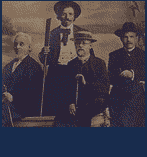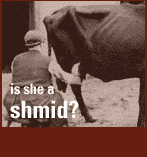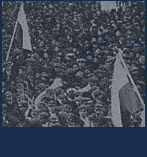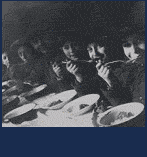


The Eastern European shtetl remains the most potent symbol of the "Old Country" for most of us. Our minds are well imprinted with the familiar images of the quaintness and "noble poverty" in the shtetl. Perhaps you imagine ramshackle villages of broken wooden shingles and dirt roads through which peddlers lead horse-drawn carts full of country goods; shoeless children playing near somber old women in tattered babushkas; the smell of challot; and the chants of prayer echoing from a wooden synagogue. In truth, this Jewish world did exist, but not everyone lived exactly this way. Some families, though few in number, made a decent living in various types of businesses. Merchants and entrepreneurs, some more successful than others, worked next to peasants and peddlers. There were Jews and non-Jews who interacted mostly through business, as well as religious Jews and not-so-religious Jews. In the shtetl there were doctors, merchants and actors; poor and middle class children, and the rich few.
Rather than view the shtetl as a country village, we might consider it as more of a small-scale urban replica. This is because shtetl Jews created a host of institutions very similar to those of the city, but of a more modest size. With sufficient numbers of Jews, the shtetl - like the shtot (city) - could support such necessary community institutions, also financed largely through voluntary taxation. For those needs in life not fulfilled in the shtetl, the cities shone like beacons in the distance, as places for greater exchange, education and community. In his memoir, Trial and Error (1949), Israeli President Chaim Weizmann (1874-1952) described his childhood in Motol, a Belarussian shtetl. The distance from "Motol to Pinsk," the capital "was a matter of …twenty-five English miles; but in terms of intellectual displacement the distance was astronomical."
The typical shtetl revolved around a central market square - the economic and social heart of the community - that hosted a weekly market day for the shtetl and its hinterlands. As one resident recalled,
"Trains of peasant wagons bearing every sort of produce from the surrounding villages arrive endlessly. At the side of the road are masses of barefoot peasants and peasant women in colorful...clothes with baskets of eggs, butter, cheese, and poultry under their arms."
As in compact cities, Jewish residents lived and worked in close proximity to the market where exchange of goods and services was the life-blood of the entire community. In addition, as in the city, Jews worked in a variety of professions, from peddling to merchandising to teaching.
The late-19th century brought tremendous upheaval and change to shtetl life. The rural economy, which had long sustained Jews and others ceased to exist. Poverty, overpopulation, and violence increased. Shtetl Jews migrated by the thousands into nearby larger cities and, when possible, to the "promised lands" of America and Palestine, carrying with them the time-honored immigrant hope of finding a better life.
Shtetlekh (Towns)
Within the broad panorama of thousands of shtetlekh that existed across Eastern Europe before World War II, one could find representations of every variety of Jewish community life: a full palette with every political current, religious movement, and intellectual subgroup of a dynamic Jewish culture. Some shtetlekh were large, boasting tens of thousands of people; some had only a few hundred. Some were nearly all Jewish, others less than half, but most, at the very least, had a very visible Jewish presence. Some shtetlekh were steeped in traditional religious Judaism, up until World War II, and others were fervent centers of secular thought, expression and organization. In general all of these shtetlekh contained aspects of each mode of Jewish life, in varying proportions, and each shtetl contained the foundations of Jewish community universal to Ashkenazi Jews: the synagogue, mikve, (bath house), schools, cemetery, trade unions, rabbis, community leaders, political parties, and, of course, the Yiddish language at the core of the culture.
While the shtetl was in many ways a smaller replica of the city, with many of the same structures, its culture was much more personal and face-to-face. The shtetl tended to be more insulated and traditional, offering a mostly self-sufficient, provincial Jewish existence. This was a thoroughly Jewish world that could seem far removed from modern technology, big city life, and, often, from non-Jews, who had their own, largely separate, culture to sustain them. The shtetl was large enough to support some Jewish institutions, and it was also small enough to be a deeply personal place, where neighbors knew one another intimately and watched over each other, with all the consequences both positive and negative that such insularity brought. In the shtetl's rich Jewish environment, one could maintain the illusion that the entire world was Jewish, with a unique Jewish cultural vibrancy. In truth, however, shtetl Jews were economically dependent on outsiders for their day-to-day business activities, often even for Jewish communal necessities such as education, poor relief and more. Nevertheless, the shtetl was a quintessentially Jewish locale, and for that reason, after World War II it became the mythologized representation of the pre-destruction Jewish life of a bygone era.












